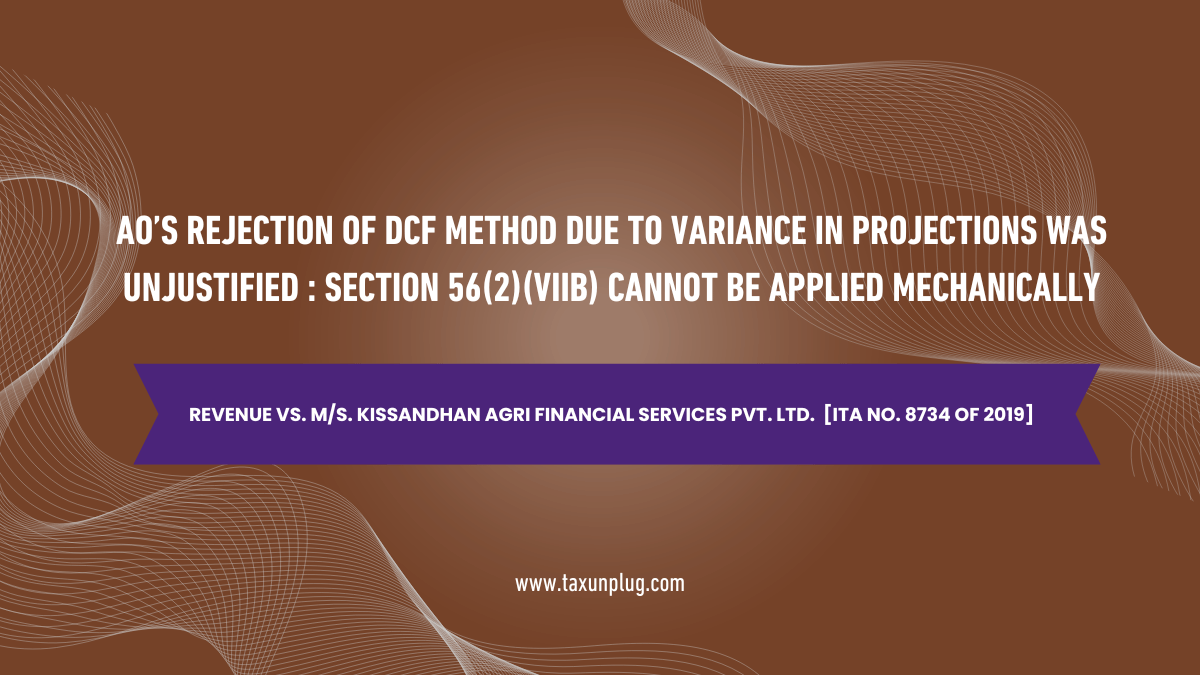AO’s Rejection of DCF Method
Revenue vs. M/s. Kissandhan Agri Financial Services Pvt. Ltd. [ITA No. 8734 of 2019]
Background of the Case
M/s. Kissandhan Agri Financial Services Pvt. Ltd., the respondent, is a company engaged in financing agricultural commodities and advancing loans. During the assessment year 2016-17, the company issued shares to its holding company, M/s. Sohan Lal Commodities Management Pvt. Ltd., at FMV of Rs. 22.21 per share against the face value of Rs. 10. The company submitted a valuation report prepared by a Chartered Accountant (CA) using the Discounted Cash Flow (DCF) method to justify the premium.
The Assessing Officer (AO) rejected the DCF method, citing discrepancies between the projected figures used in the valuation and the company’s actual financial performance in subsequent years. Instead, the AO applied the Net Asset Value (NAV) method, determining the FMV at Rs. 11.54 per share. Consequently, the AO invoked Section 56(2)(viib) and made an addition of Rs. 36,03,10,674/- to the company’s income, representing the excess premium received over the FMV.
The Commissioner of Income Tax (Appeals) [CIT(A)] reversed the AO’s decision, ruling in favor of the assessee. The Revenue then appealed to the ITAT.
Arguments by the Appellant
The appellant argued that the The AO was justified in rejecting the DCF method because the projected figures used in the valuation did not align with the company’s actual performance in subsequent years. The NAV method, based on the book value of assets, is more reliable and should be used to determine the FMV of the shares. The CIT(A) erred in deleting the addition of Rs. 36,03,10,674/- made under Section 56(2)(viib), as the premium received by the assessee exceeded the FMV determined by the AO.
Respondent’s Response
The respondent stated that the DCF method is a recognized and prescribed method for valuation under Rule 11UA of the Income Tax Rules. The valuation report was prepared by an independent CA, and the AO had no authority to reject it without cogent reasons. Projections used in the DCF method are estimates and cannot be judged based on hindsight. Variations between projected and actual figures are inevitable due to market conditions and other factors.
The shares were issued to the assessee’s wholly owned holding company, and the funds were sourced through foreign direct investment (FDI). There was no evidence of unaccounted money being routed through the transaction.
Court Findings and Decision
The ITAT bench of Delhi dismissed the Revenue’s appeal, confirming that the valuation done by the respondent using the DCF method was in accordance with the law. The DCF method is a recognized and prescribed method for valuation under Rule 11UA. The AO cannot reject a valuation report prepared by an independent expert without substantial evidence of wrongdoing. Projections used in the DCF method are based on estimates and assumptions, and variations between projected and actual figures are inevitable. The AO’s reliance on hindsight to reject the DCF method was unjustified.
Section 56(2)(viib) is an anti-abuse provision and should not be applied mechanically to genuine transactions. The AO’s addition of Rs. 36,03,10,674/- under Section 56(2)(viib) was not justified.
AO’s Rejection of DCF Method
To download official order, Click Here
“The site is for information purposes only and does not provide legal advice of any sort. Viewing this site, receipt of information contained on this site, or the transmission of information from or to this site does not constitute an attorney-client relationship. The information on this site is not intended to be a substitute for professional advice.”

